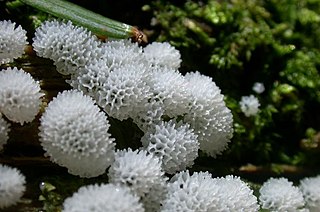
Stemonitidaceae is an family of slime molds in the order Stemonitidales. It was first circumscribed by Elias Magnus Fries in 1829.

Protosteliomycetes/Protosteliales (ICBN) or Protostelea/Protostelia/Protosteliida (ICZN) is a grouping of slime molds from the phylum Mycetozoa. The name can vary depending upon the taxon used. Other names include Protostelea, Protostelia, and Protostelida. When not implying a specific level of classification, the term protostelid or protosteloid amoeba is sometimes used.

Myxogastria/Myxogastrea or Myxomycetes (ICBN), is a class of slime molds that contains 5 orders, 14 families, 62 genera, and 888 species. They are colloquially known as the plasmodial or acellular slime moulds.
Physarales is an order of Amoebozoa in the class Myxomycetes. It contains three families, the Didymiaceae, the Lamprodermataceae, and the Physaraceae. Physarales was circumscribed by Thomas Huston Macbride and published in 1922.
Barbeyella minutissima is a slime mould species of the order Echinosteliales, and the only species of the genus Barbeyella. First described in 1914 from the Jura mountains, its habitat is restricted to montane spruce and spruce-fir forests of the Northern Hemisphere, where it has been recorded from Asia, Europe, and North America. It typically colonises slimy, algae-covered logs that have lost their bark and have been partially to completely covered by liverworts. The sporangia are roughly spherical, up to 0.2 mm in diameter, and supported by a thin stalk up to 0.7 mm tall. After the spores have developed, the walls of the sporangia split open into lobes. The species is one of the smallest members of the Myxogastria and is considered rare.
Amaurochaete is a genus of slime molds in the family Amaurochaetaceae. As of 2015, there are four species in the genus.
Collaria is a genus of slime molds in the family Lamprodermataceae.
Colloderma is a genus of slime molds in the family Lamprodermataceae. As of 2015, there are four species in the genus.
Diacheopsis is a genus of slime molds in the family Lamprodermataceae. As of June 2015, there are 16 species in the genus.

Enerthenema is a genus of slime molds in the family Amaurochaetaceae. As of 2015, there are four species in the genus.
Macbrideola is a genus of Amoebozoa in the family Stemonitidaceae. As of 2015, there are 17 species in the genus.
Stemonaria is a genus of slime molds in the family Amaurochaetaceae. As of June 2015, there are 14 species in the genus.
Symphytocarpus is a genus of slime molds in the family Stemonitidaceae. As of June 2015, there are nine species in the genus.
Physarina is a genus of slime molds in the family Physaraceae.
Physaraceae is a family of slime molds in the order Physarales.

Diderma is a genus of slime molds in the family Didymiaceae. The genus was first described by Christiaan Hendrik Persoon in 1794, and the type species is Diderma globosum.
Brefeldia is an genus of slime molds in the family Amaurochaetaceae.

Stemonitidales is an order of Amoebozoan slime molds in the class Myxomycetes.
Amaurochaetaceae is an family of slime molds in the order Stemonitidales.

Tubifera ferruginosa, more commonly known as raspberry slime mold or red raspberry slime mold, is a species of slime mold in the class Myxogastria. It is one of the most widely known and distinct slime molds, being found throughout temperate regions of the world, primarily in Europe and North America.










